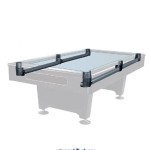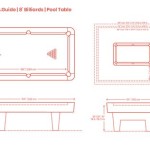Modern Farmhouse Dining Room Table Decor: A Comprehensive Guide
The modern farmhouse aesthetic, characterized by its blend of rustic charm and contemporary sophistication, has become a dominant force in interior design. The dining room, as a central gathering space, offers ample opportunity to showcase this hybrid style. A well-decorated dining table is pivotal in establishing the desired ambiance, serving as both a functional surface for meals and a visual focal point for the room. This article will explore various elements and strategies for effectively decorating a modern farmhouse dining room table.
The essence of modern farmhouse decor lies in its ability to balance the raw, natural elements of traditional farmhouse design with the clean lines and minimalistic tendencies of modern style. This translates to a dining table adorned with items that evoke a sense of warmth, history, and simplicity, while avoiding excessive ornamentation or overly fussy details. The selection of materials, color palettes, and decorative objects should all contribute to this harmonious balance.
Selecting the Right Foundation: The Dining Table
The dining table itself is the foundational element of the decor. Choosing the right table is crucial for establishing the overall tone of the dining room. Solid wood tables, particularly those with visible grain and natural imperfections, are a popular choice. Reclaimed wood adds a layer of character and history, perfectly embodying the farmhouse aesthetic. Tables with trestle bases or turned legs often feature prominently, lending a touch of rustic elegance. Conversely, pairing a wooden tabletop with sleek, metal legs can introduce a modern edge to the design.
Shape and size are also important considerations. A rectangular table is a classic and versatile option, suitable for both casual and formal dining. Round tables encourage conversation and create a more intimate atmosphere, while oval tables offer a softer alternative to the rectangular form. The size of the table should be proportionate to the size of the dining room, ensuring comfortable seating and sufficient space for movement.
For a true modern farmhouse look, consider incorporating unexpected materials or finishes. A concrete-topped table, for example, offers a contemporary twist on the traditional wood table. Painted tables, particularly in distressed or muted colors, can also add a touch of character and personality. The key is to choose a table that complements the overall aesthetic of the room and serves as a suitable canvas for the decorative elements.
Layering with Textiles: Runners, Placemats, and Napkins
Textiles play a vital role in softening the hard surfaces of a dining table and adding visual interest. Runners, placemats, and napkins provide opportunities to introduce texture, color, and pattern to the table setting. Linen, cotton, and burlap are common fabric choices for modern farmhouse decor, offering a natural and understated elegance.
Table runners can be used to create a focal point down the center of the table. A simple linen runner in a neutral color is a versatile option, while a patterned runner can add a pop of visual interest. Consider runners with subtle stripes, checks, or floral motifs to complement the farmhouse aesthetic without overwhelming the design. The length of the runner should extend beyond the edges of the table, creating a graceful drape.
Placemats provide individual settings for each diner and can be used to protect the table surface. Woven placemats, such as those made of jute or seagrass, add a natural texture and complement the rustic charm of the farmhouse style. Fabric placemats in coordinating colors or patterns can also be used to create a cohesive look. Circular or rectangular placemats can be chosen based on the shape of the plates and the overall design aesthetic.
Napkins, whether linen, cotton, or a blend of fibers, offer another opportunity to add a touch of elegance to the table setting. Simple, folded napkins placed to the left of the plate or tucked into napkin rings are a classic choice. For a more casual look, napkins can be tied with twine or ribbon and placed on top of the plates. Consider using a variety of napkin folds to add visual interest and personality to the table setting.
When selecting textiles, pay attention to the color palette. Neutral colors, such as white, beige, gray, and brown, are foundational to the modern farmhouse aesthetic. These can be complemented with pops of color, such as blues, greens, or reds, to add visual interest and personality. Consider using a mix of solid colors and patterns to create a layered and textured look.
Creating a Centerpiece: Balancing Natural Elements and Functionality
The centerpiece is arguably the most important element of dining table decor, serving as the visual anchor for the entire setting. A well-chosen centerpiece can elevate the dining table from functional furniture to a stunning focal point. In the modern farmhouse style, centerpieces typically incorporate natural elements, such as greenery, flowers, or wood, arranged in a way that is both aesthetically pleasing and functional.
Floral arrangements are a popular choice for centerpieces. Wildflowers, herbs, and branches can be arranged in simple vases or jars to create a rustic and charming display. Consider using a variety of flower types and colors to add visual interest. Alternatively, a single type of flower in a monochromatic arrangement can create a more sophisticated and understated look. For a longer-lasting option, consider using dried flowers or artificial greenery.
Greenery, such as eucalyptus, ferns, or olive branches, can also be used to create a lush and vibrant centerpiece. These can be arranged in vases or laid directly on the table as a garland. Greenery adds a touch of freshness and vitality to the dining room, complementing the natural elements of the modern farmhouse style. Consider using a mix of different types of greenery to create a layered and textured display.
Wood elements, such as branches, logs, or wooden bowls, can also be incorporated into the centerpiece. These add a touch of rustic charm and connect the dining table to the natural world. Wooden bowls can be filled with fruit, vegetables, or decorative objects to create a visually appealing display. Branches can be arranged in vases or used as decorative accents. Consider using reclaimed wood or driftwood for added character and history.
Candles are another essential element of dining table decor, adding warmth and ambiance to the dining experience. Candles can be arranged in candlesticks, lanterns, or votives to create a soft and inviting glow. Taper candles are a classic choice, while pillar candles offer a more substantial presence. Consider using a variety of candle heights and sizes to add visual interest. Scented candles can also be used to create a pleasant aroma in the dining room.
When creating a centerpiece, it is important to consider the size and shape of the table. A long table may require a larger centerpiece or multiple smaller arrangements to avoid looking sparse. A round table may benefit from a single, central arrangement that is proportional to the table's diameter. The height of the centerpiece should also be considered, ensuring that it does not obstruct the view of diners across the table. Aim for a centerpiece that is between 12 and 18 inches tall, or lower if it is a longer arrangement running down the table.
Furthermore, the functionality of the centerpiece should also be considered. Avoid using items that are too delicate or easily knocked over. Choose items that are easy to clean and maintain. Consider using a tray or platter to contain the centerpiece and protect the table surface. The goal is to create a centerpiece that is both aesthetically pleasing and practical for everyday use.
Other objects that can be incorporated into a modern farmhouse dining table centerpiece include vintage books, mason jars, antique scales, and decorative spheres. These items add character and personality to the table setting, reflecting the individual style of the homeowner. The key is to choose items that are authentic to the farmhouse aesthetic and complement the overall design of the dining room.
Ultimately, decorating a modern farmhouse dining room table is about creating a space that is both beautiful and functional. By carefully selecting the table, layering with textiles, and creating a balanced centerpiece, a dining room can be transformed into a warm and inviting gathering place that reflects the charm and sophistication of the modern farmhouse style.

Modern Farmhouse Dining Room Micheala Diane Designs

Modern Farmhouse Dining Rooms Countryside Amish Furniture

Home Style Trend The Modern Farmhouse Dining Room Of Your Dreams Rooms Decor Table Centerpieces

Modern Farmhouse Dining Room Remodel Hallstrom Home

Family Dining Table Ideas Farmhouse Style Room Rooms Decor Modern

31 Tricks For Incorporating Farmhouse Dining Table Décor

Elba S Nesthouse Farmhouse Decor Superstar Design Inspiration And Community We Share Ideas An Rustic Dining Room

Modern Farmhouse Easter Decor A Wonderful Thought

62 Farmhouse Dining Rooms And Zones To Get Inspired Digsdigs

Modern Farmhouse Dining Room Remodel Hallstrom Home








